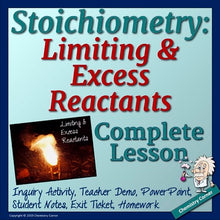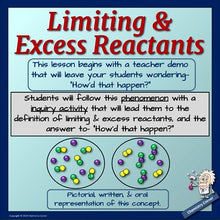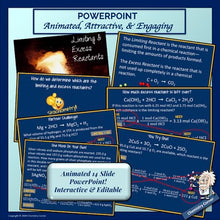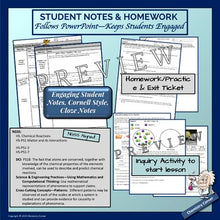This NGSS aligned lesson begins with a teacher demonstration of a phenomenon that will leave your students asking— “How’d that happen?” Follow the demonstration with a student led inquiry activity that will lead students to a definition of limiting reactant and excess reactant. Students will represent the reaction both pictorially and with written description. By the end of the activity, students should be able to participate in an informed conversation of exactly what happened during the demonstration.
The emphasis of this lesson is on concept development of limiting and excess reactants as it relates to the balanced equation, and not on memorization and rote application of problem-solving techniques.
The Teacher Notes included with this lesson include detailed instructions for the teacher demonstration and inquiry activity.
In this lesson, students will identify the limiting reactant and the excess reactant in a chemical reaction. They will use the limiting reactant to determine the amount of product formed in a reaction.
This lesson goes well with my Conversion Game-The Stoichiometry Edition. Or, try the Stoichiometry Scavenger Hunt, or stoichiometry task cards with white boards to give students more practice.
Objectives:
• Define limiting and excess reactants.
• Use stoichiometric calculations to determine the limiting and excess reactant.
• Determine the amount of excess reactant remaining after reaction has run.
• Using the limiting reactant, use stoichiometric calculations to determine the amount of product formed.
• Show a qualitative understanding of the phenomenon of limiting and excess reagents in a chemical reaction through pictorial and conceptual examples.
NGSS:
HS. Chemical Reactions
HS-PS1 Matter and its Interactions
HS-PS1-2
HS-PS1-7
DCI: PS1B: The fact that atoms are conserved, together with knowledge of the chemical properties of the elements involved, can be used to describe and predict chemical reactions.
Science & Engineering Practices—Using Mathematics and Computational Thinking: Use mathematical representations of phenomena to support claims.
Cross-Cutting Concepts—Patterns: Different patterns may be observed at each of the scales at which a system is studied and can provide evidence for causality in explanations of phenomena.
Prior Knowledge for Students: Students should be comfortable with dimensional analysis, nomenclature, molar mass, writing chemical equations for reactions, mole conversions, and basic stoichiometry prior to this lesson.
Teacher Prep Time: Just print and go!
Lesson Duration: Two class periods plus practice.
Included in This Product:
Teacher demonstration (phenomenon to begin class)
Student Inquiry Activity
Student inquiry Activity Answer Sheet
Editable, Animated PowerPoint (17 slides)
Cornell Style Student Notes that follow the PowerPoint (Cloze Notes)
Student Example of Completed Notes
Homework/Practice assignment w/KEY—all problems completely worked out
Check for Understanding (exit ticket) w/KEY
Teacher Notes pages (4 pages) Detailed instructions for the demonstration and inquiry activity, and slide-by-slide background notes for the PowerPoint.
Note on the PowerPoint: The PowerPoint included in this product is editable. It is also animated, which means that it may appear busy or overlapping in the slide edit mode, but will be awesome in the slide show mode! Please don’t edit the PowerPoint until you have seen it in the slide show mode!
This lesson is appropriate for grades 9-12 chemistry.
This will be a lesson you will want to use year after year!
Chemistry Corner
**************************************************************************************
Check out these other products that you may be interested in:
Stoichiometry: A Complete Lesson
Chemistry Board Game Conversion- Stoichiometry Edition
Stoichiometry Scavenger Hunt with QR Codes
High School Chemistry Year Curriculum
*************************************************************************************
Chemistry Corner’s PowerPoints are perfect for the flipped classroom. However, please read the Copyright Terms below before using it as such. Thanks!
LICENSING TERMS: By purchasing this product, you own a license for one teacher only for personal use in your classroom. Licenses are non-transferable, meaning they cannot be passed from one teacher to another. No part of this resource is to be shared with colleagues or used by an entire grade level, school, or district without purchasing the proper number of licenses. I you are a coach, principal or district interested in transferable licenses to accommodate yearly staff changes, please contact beth@chemistrycorner.com.
COPYRIGHT TERMS: ©Chemistry Corner. Please note – all material included in this resource belongs to Chemistry Corner. By purchasing, you have a license to use the material, but you do not own the material. This resource, or any portion of this resource, may not be uploaded to the internet in any form, including classroom/personal websites or network drives, unless the site is password protected and can only be accessed by students—no other teachers or anyone else on the internet.








